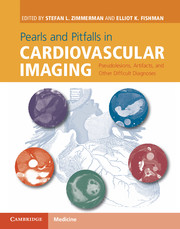 Pearls and Pitfalls in Cardiovascular Imaging
Pearls and Pitfalls in Cardiovascular Imaging from Section 5 - Pulmonary arteries
Published online by Cambridge University Press: 05 June 2015
Imaging description
Pulmonary arteriovenous malformations (AVM) are defined by an abnormal communication between pulmonary arteries and veins. AVMs may be simple or complex depending upon the number of feeding arteries. A simple AVM is fed by one or more arterial branches arising from a single pulmonary segment; a complex AVM is fed by arterial branches from more than one segment. Computed tomography (CT) is a wellestablished modality for making the diagnosis, as well as for the assessment of size and distribution for preangiographic treatment planning. CT findings include single or multiple smooth, round or lobulated pulmonary nodules or serpiginous masses with feeding and draining vessels mostly in the lower lobes (Figure 45.1A). Multiplanar reformations with thin sections and maximal intensity projection (MIP) images are particularly helpful for confirming the diagnosis (Figures 45.1B, 45.1C, and 45.2). Although morphologic findings are sufficient for making the diagnosis, IV contrast may be administered for confirmation. AVMs follow rapid contrast opacification and washout of the main pulmonary artery. Catheter pulmonary angiography remains the reference standard for diagnosis.
Importance
Correct diagnosis is important, especially when the AVMs are small and may be confused with lung nodules or cancer (Figures 45.1B and 45.1C). This could expose the patient to risks of unnecessary imaging and/or invasive testing such as a biopsy, which may be catastrophic due to severe bleeding. MIP images can increase sensitivity for detection of small lesions.
Typical clinical scenario
The majority of pulmonary AVMs are congenital in etiology. The prevalence of pulmonary AVMs as estimated by low-dose thoracic CT is at 38 per 100,000 individuals.
Among patients with pulmonary AVMs, 70–90% have hereditary hemorrhagic telangiectasia (HHT), an autosomal dominant disorder characterized by AVM in the skin, mucous membranes, and viscera. Conversely, only up to 35% of patients with HHT have pulmonary AVMs, which are more symptomatic when multiple and bilateral.
AVMs result in right-to-left shunting of blood and can lead to cyanosis depending on the size of the shunt. An echocardiographic bubble study can be used to detect the shunt and estimate its severity.
To save this book to your Kindle, first ensure [email protected] is added to your Approved Personal Document E-mail List under your Personal Document Settings on the Manage Your Content and Devices page of your Amazon account. Then enter the ‘name’ part of your Kindle email address below. Find out more about saving to your Kindle.
Note you can select to save to either the @free.kindle.com or @kindle.com variations. ‘@free.kindle.com’ emails are free but can only be saved to your device when it is connected to wi-fi. ‘@kindle.com’ emails can be delivered even when you are not connected to wi-fi, but note that service fees apply.
Find out more about the Kindle Personal Document Service.
To save content items to your account, please confirm that you agree to abide by our usage policies. If this is the first time you use this feature, you will be asked to authorise Cambridge Core to connect with your account. Find out more about saving content to Dropbox.
To save content items to your account, please confirm that you agree to abide by our usage policies. If this is the first time you use this feature, you will be asked to authorise Cambridge Core to connect with your account. Find out more about saving content to Google Drive.